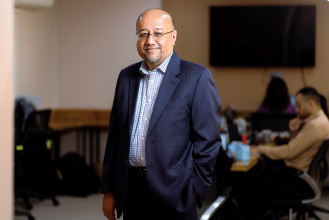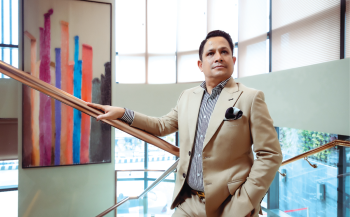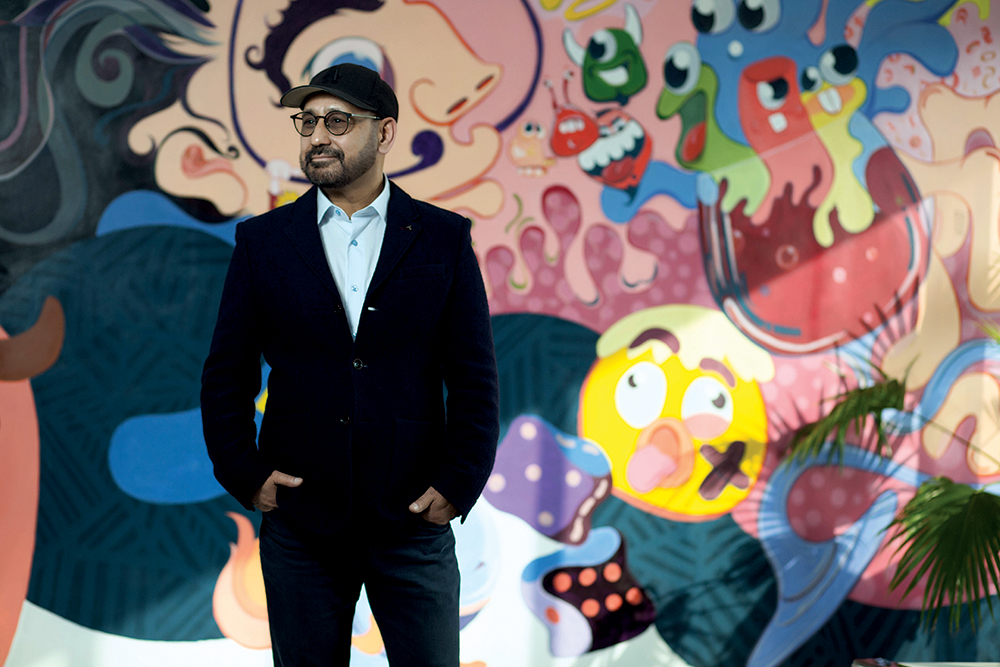
KIRAN BHAKTA JOSHI
FOUNDER & CO-CEO, INCESSANT RAIN
With over three decades of experience in the animation industry and involvement in over eighty Hollywood movies, Kiran Bhakta Joshi, Founder and co-Chief Executive Officer of Incessant Rain is driven by creativity, passion, innovative visual technology, and his stellar ability to merge the real with the unreal. Prior to establishing Incessant Rain, Joshi was the Visual Effects Supervisor at The Walt Disney Studios where he worked on films such as ‘Beauty and the Beast’, ‘Aladdin’, ‘The Hunchback of Notre Dame’, and ‘The Lion King’, to name a few. He was also involved with the early development of ‘Tangled’ and ‘Frozen’ at Disney before leaving to establish his own studio. Incessant Rain was first set up in 2008 as an animation and VFX company but over the years has expanded to become an original content creator and production company. The project portfolio of the studio today includes VFX services, animated features, and original content for global audiences. At present, Joshi is focusing on creating content that is local but appeals to the global audience. “Squid Game was a massive hit among the audience due to its original content. We too are developing some local stories like the ‘Yeti Man’ and ‘Gurkhas vs. Ninjas’,” he shares, adding that the demand for such content is only on the rise. The global animation market is estimated to reach a value of $587.4 billion by 2030. At Incessant Rain, Joshi is also attempting to create an equitable workplace. He has laid emphasis on ESG in the company and developed a culture of diversity and inclusion along with a strong focus on coaching and idea culture. Joshi in conversation with Business 360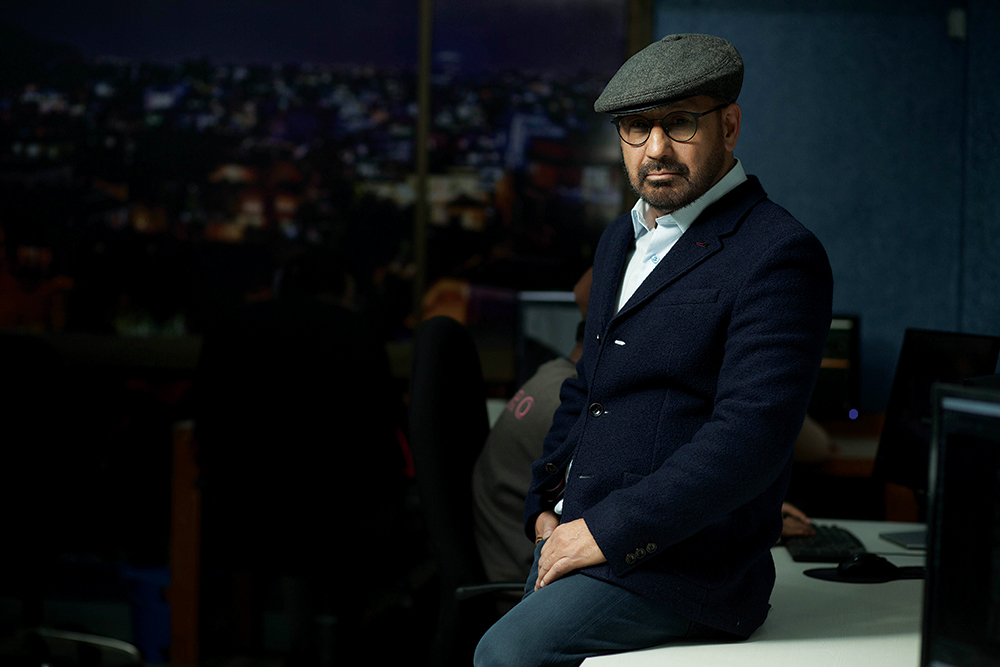
When you got into animation, it was not a sector that people would give serious thought to as a career. What led you to it?
When I left Nepal to go and study in the United States, I was only 19 years old and to be very honest I had no idea about animation. As a kid, we used to watch a lot of animated series and get fascinated by them but that was it. Back then, parents wanted their children to study medicine or engineering but I wanted to do something different and decided to study nuclear physics which was relatively unknown subject here. I, thus, applied for an undergraduate programme in nuclear physics and was accepted. But one day before college started, I was walking down a street and I noticed a crowd in one of the stores. They were flocking around these small boxes which apparently were IBM personal computers. At that moment, I hadn’t even heard of one. I walked into the store and they were displaying a few things. I found it so interesting I immediately went to college and changed my area of study to computer engineering and got into computer graphics. After graduating, I started working in a company that used to make mini computers that were being used by banks and traders. After having worked for five years in that firm, one day I noticed a job opening for a software developer in Disney. At that time Disney was transitioning from traditional hand drawing to digital drawing. Previously, all the sketches used to be made manually and later painted. When I went for the job interview, I found out that there were more than a hundred applicants for just three slots. It was quite disheartening to see so many applicants because I knew nothing about animation and thought I didn’t stand a chance. However, I went through the process and was luckily selected.I met a 19-year-old boy and the work he showed me was very impressive. What was even more remarkable was he was a self-taught kid. I was complimenting him and instead of thanking me, he was very upfront and told me that if someone like me did not create a platform for people like him then the next time I came to Nepal I would probably bump into him at a bank.My first assignment in Disney was for ‘Beauty and the Beast’ where I helped create some digital aspects. Though I was into programming and still learning, I was more fascinated by the art side. For ‘Beauty and the Beast’, I provided the software component to support the animation. Then after a few months, they were putting together a team for ‘The Lion King’. They had selected a director, producer and a small team. One of the challenges that cropped up in the movie was creating the sequence for the wildebeest stampede. They realised it was not possible to do so by drawing it manually and it had to be done digitally. So, they put a group of us together and said that while they were developing the story we needed to resolve that problem. As fate would have it, I was one of the key people in the team who helped create that particular sequence. This basically made me stand out in the company. Otherwise, I was just somebody who was writing codes. I got recognised and was promoted as the computer graphics supervisor. In the process I started learning animation and became more interested in it. Then I worked on ‘The Hunchback of Notre Dame’, ‘Atlantis: The Lost Empire’ and ‘Tangled’ which initially was titled ‘Rapunzel’. I also worked on ‘Frozen’, which was initially named ‘Snow Queen’. Over time, I became one of the few they would single out to solve problems that were very difficult.
You were associated with a globally renowned company and a secure career in the US, what made you come back to Nepal and start Incessant Rain?
While still working in Disney, in 2007, I got a call from Nepal informing me about my brother-in-law’s death. I, thus, had to accompany my nephew and niece for the final rites as they were still small. After the last rites were over, they returned but I decided to stay back for a couple of weeks to visit friends and family. It was then a friend who asked me why not give a thought to starting an animation studio here. I had previously never given it a serious thought but when my friend gave me that suggestion, it got me thinking. I started thinking of whether we had the required talent and skillsets in Nepal. There was a company called Transcube where they were training people in animation. They wanted to get something going so I went to meet the owner of that firm. There were many youngsters there and I started talking to them. In the meantime, I extended my leave for three weeks to get a better understanding of the situation here. During those three weeks, I saw amazing portfolios of many young people who were mostly in their teens. I saw some spark but was still not convinced. It was just a couple of days before I had to return, I met a 19-year-old boy and the work he showed me was very impressive. What was even more remarkable was he was a self-taught kid. I was complimenting him and instead of thanking me, he was very upfront and told me that if someone like me did not create a platform for people like him then the next time I came to Nepal I would probably bump into him in a bank. Animation was something he was passionate about but due to the pressure from his family he was studying management. That incident really hit me hard. When I had gone to the US, I was the same age that he was but at that time I didn’t know what I wanted to become and here was this young guy who knew exactly what he wanted to do if given the opportunity. That conversation was so provoking I went back home and spoke to my wife about giving the idea of starting a studio here a shot. I had met around 25 people and the next day I called 19 who I thought were good. We met and I told them that this is the right time so I will return and by January we will have an animation studio here and you guys will be a part of that. They did say okay then but later I found out that none of them believed I would come back. Before I left, I hired an interior architect and we chose a place and our first office was located in Naxal.
What were the initial challenges?
Like I had promised the youngsters I came back in January and we started with a team of 20 people. As I was putting together the team, I was also teaching them and initially I thought that would be the most difficult part. However, they were quick to pick up the tools and techniques. The biggest challenge was communication. I used to organise brainstorming sessions and I realised I was the only person speaking in the room; there used to be no contribution at all from anyone. So, one afternoon I decided to take them all to a café in an informal setting and soon everybody was talking. I had to literally ask some to stop speaking. The first lesson I learnt was that we Nepalis are very structured with many rules of obedience and people would not speak freely to their seniors in an office setting. It took me quite some time to break that barrier. The other challenge was that after six months I realised we couldn’t keep investing in the company with no earnings. So, I went back to Disney and requested Don Hahn, a reputed producer who worked in ‘The Lion King’, for some work. Initially, he was a bit sceptical on whether our team in Nepal would be able to fulfil the assignments. He thought I would take work and then outsource it to another company in India. He jokingly told me how could we have a studio where there are yaks running around and no electricity. But that was a fact. At the time we were having to deal with 18 hours of load-shedding but I couldn’t tell him that. The first project I got was from Disney which was ‘Mickey Mouse: The Diwali Project’. We were given an eight-week deadline to complete it and I told my team that we had to finish it within the deadline whether we had to work day or night. Though I didn’t tell the team I was really scared that if we couldn’t pull it off then I would have to pack my bags and leave.If the younger generation can come up with crazy creative ideas, then Nepal will be on the global map of films. That is important, not just doing a job but taking your stories to the world.The first project was very crucial for me not only to get the company up and running but also to prove that the decision to leave a secure job and open a company in Nepal would not go in vain. My friends were sceptical of my decision and I had to prove them wrong. It was a hectic period and for the last 12 days we slept in the office to finish the project. It was the first time my team members understood the concept of what a deadline is. In the movie or TV industry all the dates are slated. If a movie has to be released on a particular date it has to be and it is the same with the TV series. With other types of jobs if you don’t meet the deadline, you can push it by a couple of days but not in the movie industry. So, the team not only learnt about deadlines but also about how this is such a collaborative thing. From there we have been growing as a company.
How has Incessant Rain evolved over the years?
We started with 20 people and within a year we were 35. It was difficult because I had to train the people myself. There are some animation academies here but they only teach the tools and not the fundamentals. Growth was slow but soon we outgrew the office space and shifted to another location by when we had 70 staff members. Our philosophy was to bring in young people who are passionate and put them through an internal training for five to six months and when they make it through that, we bring them to the production. We provide the training free. Initially, we hire them as interns and after three months of internship they start working full time. Obstacles are always there like at times a client comes to us to produce an 80-minute film and at times some come with a short movie but want it immediately. So, the tricky part was that at times projects would come and we didn’t have the resources and then some small ones wanted it immediately. I realised we needed to diversify and added visual effects. Also, there is more work in visual effects than in animation or cartoons. Every movie has some sort of digital content whether it be creating an explosion or a fire. So, we further grew and moved to another site by when we had 130 employees. In the last eight years we have been in the current location, and we have over 200 people. Our growth has been organic. We did suffer during Covid because we could not organise training programmes. It was a challenging phase and we started making documentaries and developing our own stories. I soon realised I wouldn’t be able to handle everything on my own because the industry was going through rapid changes. So, in 2021, I asked a friend, Deepa Chipalu Joshi, if she would be willing to join us and thankfully, she quit her job and joined us. Previously, I was the founder and the CEO but when she came in, I decided to divide the role equally and we were both co-CEOs. I look after production, technology and creativity aspects and she is responsible for training, finance, HR, operations and all those aspects because she comes from a business background. But more than that, I wanted to send a message about equality. Across the corporate world, we can notice that very few women occupy senior positions. So, I don’t want an environment where a female would be reporting to me. I wanted to set that example right from the top. Also, all the employees will feel we are equal regardless of our gender. We also started introducing gender justice programmes in the office and encouraging female artists. What usually happens in Nepal is most women sacrifice their careers after they get married but we have to understand that a career is as important for a female as it is for a man. We have lost many promising female employees solely due to that reason. Deepa started rummaging through our list of former women employees who had left for that reason, and we were able to convince former women artists. Renu Shrestha is an example of that effort. Initially, Renu was apprehensive about joining because it had been a few years since she had quit and lacked the confidence but now, she is with us and her performance is fantastic. In our own small way, we are trying to bring about positive change. A woman’s career is as important as a man’s, and that is something everybody needs to understand. So, we branded our company as an ESG firm. However, when we speak about gender it is not only about women but also men and the LGBTQIA+ community. What we are trying to do is promoting more opportunities and educating the human resources. And it was an honour to be invited to the Annecy International Animated Film Festival in France in June 2022, which is the Cannes of animation, where our co-CEO, Deepa Chipalu Joshi, made a presentation on what we were doing in terms of gender justice among all the studios in Southeast Asia. We are also trying to bring in Women in Animation to Nepal. Women in Animation is a not-for-profit based in the United States. It is a very powerful organisation which is promoting female directors, art directors, skilled artists, and it also works to promote professionals of the LGBTQIA+ community.Can you share your thoughts about the Incessant Rain Academy…
The industry has changed so much now. About a decade back the streaming industry took foothold around the world. There are so many streaming platforms these days. Previously, the content we used to make was seasonal for the spring and fall seasons and there used to be a gap in the summers. Also, we had limited number of theatres. Now if you observe there is continuous demand for content which means this industry has boomed. So, the demand for content has grown exponentially and the biggest challenge now is the shortage of digital artists. So, the academy was opened to fill that void. What is really changing the landscape at present is the evolution of the metaverse. The future I will emphasise is the metaverse. When the internet was first launched around 25 years back people were still stuck with the traditional ways of doing things but over the decades it gathered so much pace that now you cannot imagine a company without a website, an online presence. Similarly, right now people are talking about privacy, security and abuse of system while referring to metaverse but the fact is that it is not going to go away. It is just going to grow. Due to that there is a shortage of talent. Around 30 years back, there was a shortage of software developers and companies like Microsoft and IBM had to rely on India for computer programmers. Initially, they used to hire Indian talent on short-term contracts but the demand just kept growing and they had to set up offices in India itself. I see that is what is going to happen in the digital artist sphere. Previously, we had one TV and all family members would watch one programme but now every individual has a mobile device and are watching different shows. So, the demand for content has grown which means that somebody has to create that. The next big bang will be digital artists. Training 60 people a year in our office is not going to suffice. We need more manpower. So, we opened Incessant Rain Academy and our goal is to have 1,000 digital artists in the next four years who can be utilised either for our company or other companies. If we have a large talent pool here, we will also be able to bring more work to Nepal. The largest segment of the population here is the youth, most of whom are going abroad for better opportunities. We believe we can stop this trend of talent taking flight from the country through this initiative. At present, we are not affiliated to any university but ultimately, we will associate ourselves with a well-recognised animation school in the US. When Walt Disney opened his studio, he faced the same problem of a shortage of animators and to cope with this issue he opened CalArts school. CalArts has churned out the finest talents in Hollywood like Tim Burton for example. I hope one day graduates from our academy will be the Nepali equivalent of the Tim Burtons in the world.Across the corporate world, we can notice that very few women occupy senior positions. So, I don’t want an environment where a female would be reporting to me. I wanted to set that example right from the top. Also, all the employees will feel we are equal regardless of our gender. We also started introducing gender justice programmes in the office and encouraging female artists. What usually happens in Nepal is most women sacrifice their careers after they get married but we have to understand that a career is as important for a female as it is for a man.Any person joining our academy will learn many tools and techniques but above it all, I want them to keep the creativity alive. I want them to create stories, make films, and take it to the world. If the younger generation can come up with crazy creative ideas, then Nepal will be on the global map of films. That is important, I feel, not just doing a job but taking your stories to the world. Create something that can be enjoyed by the global audience and do not limit your creativity for local market consumption only. We have been consuming what is being made outside the country for a long time and I believe it is time we create something that the world wants. That is why I opened the academy. I know it is important to study, be trained and get a job and be financially stable but at the back of the mind, your fundamental drive should be to create something that you can highlight to the outside world. Don’t limit yourselves.

What is the concept behind the ‘Yeti Man’, ‘Gurkhas vs. Ninjas’ and ‘Frostbite’?
I have been involved in scores of films and you can see so many movie posters adorning the walls of our office. They are important because they are our bread and butter. But my passion is really about how do we take stories outside that we take for granted here. When we talk about Yeti, most people here say it is a banmanchhe (somebody who lives in the jungles). People from outside Nepal view it as a monster. However, I see Yeti as a brand which we can show to the world as a superhero. The story we are developing has a strong message. It is a big-money project with a budget of $15 million and we are receiving funding gradually. Hopefully we will be able to complete the movie soon. The ‘Gurkhas Vs. Ninjas’ is more about creating shorts and putting them up as episodes. One of the reasons why we are doing that is to explore technology. Every other day there is always new software and technology being introduced. If we stick with doing only what clients assign us, then we will be confined within that circle. We are trying to collaborate with the Unreal Engine concept of Epic Games, which is a multi-billion-dollar company and a platform for game developers. They are the number one player in their segment and have a huge market. When we went for the Annecy International Animation Film Festival, we met the Vice President of Epic Games, and talks are being held to use their technology for our films and TV shows. In fact, they have trained 25 of our artists. We are doing that to build our skillset and going forward we will look into it more.Every other day there is always new software and technology being introduced. If we stick with doing only what clients assign us, then we will be confined within that circle. We are trying to collaborate with the Unreal Engine concept of Epic Games, which is a multi-billion-dollar company and a platform for game developers.‘Frostbite’ is a live action film written by my friend, Zack Stentz, who is a co-writer of Marvel blockbusters such as ‘Thor’ & ‘Xmen: First Class’. Incessant Rain is partnering with his production company, Electric Brain Entertainment on the film. ‘Frostbite’ is a Nepal-set suspense thriller and 95% of the film will be shot in Nepal with many Nepali actors and crew.
Where do you see the animation industry heading in the future?
May be not in Nepal but every movie being produced these days has a digital aspect, whether it is visual special effects or animation. Recently, Netflix used Artificial Intelligence to create a three-minute short anime. I would like to reemphasise that metaverse and artificial intelligence are here to stay. Initially, when we started using computers to make cartoons, traditional artists would complain that we are taking away their work and it is not good for the art sector. But what everyone is realising now is that you can do things which you would not have been able to earlier. Those who embraced technology are doing good. Technology is always going to move ahead and what I would say is any company, no matter which sector, has to embrace technology. The demand for digital artists is only going to rise.Anything you would like to see changed for a better business environment?
A lot of people in Nepal do not understand the work we are doing, or some don’t even know for that matter. But when I go to the US, I tell the people there that in a place like Nepal you have a small piece of Hollywood. What people are seeing worldwide, a small piece is being done here in Nepal. These are small things people do not realise. And when I am there, people ask how it is like to do business here. I tell them it is like in any country with the usual challenges but when you look at it realistically, Nepal is one of the worst places to start a business. Over the last 15 years we have grown from 20 staff to just over 200 but what I can confidently state is if I had set up this company back then in India, we would have had 1,000+ people now. One problem is the resource crunch. To make it worse every step here is like a hurdle. The government here seems oblivious to what is needed to better the business climate. During Covid when we had to stay home, at times, I used to get this feeling of why I set up the company in Nepal. If I had opened it in India, I would have had 1,000+ artists. At times you get this feeling but again Deepa reminds me that I did not start the company to only earn money but because that little boy sparked something within me; to create jobs and help uplift youngsters here. However, the government doesn’t understand this. Moreover, we are a company that brings in dollars, and yet the government doesn’t realise this fact. If anything happened now, we could take this company to India and within a month it will be completely transplanted there with no presence here because this business is all about relationships. It is not a factory. I am dependent on clients and knowledge. I can take some key people from here and hire some there and within a month or two we could transition. The government creates obstacles in even taking dividends. The other problem is related to some sector specific policies. People often ask why I don’t make films in Nepal. The problem is I am not allowed to make one. As an FDI company I am not allowed to make a Nepali movie. The film industry in Nepal is run like a syndicate type of business. Any policy, I would say, is influenced and those making movies here have used that influence to introduce policies that restrict us from making Nepali movies. However, at times, one needs to take certain things with a pinch of salt and look for other avenues, so, I told myself that if I cannot make a movie for the Nepali market then at least I can make Nepal a film-making destination. Most people do not have any idea behind why Squid Game was so successful. 10-15 years ago, it would not have been accepted. What is happening now is with the amount of content that is growing for global consumption people are looking for diversified authentic content. People do not want to always watch western content; they want to see different things. Even I watch Korean movies. We are in a state where people are hungry to listen to stories from different parts of the world. The reason why ‘14 Peaks’ became famous was because of the authentic content. There were movies regarding the mountains previously but ‘14 Peaks’ became famous due to its authentic packaging. So, this is the perfect time to take stories from this part of the world to the global audience and the government needs to assist those involved in it. READ ALSO:
Published Date: February 27, 2023, 12:00 am
Post Comments
E-Magazine
RELATED In the Lead

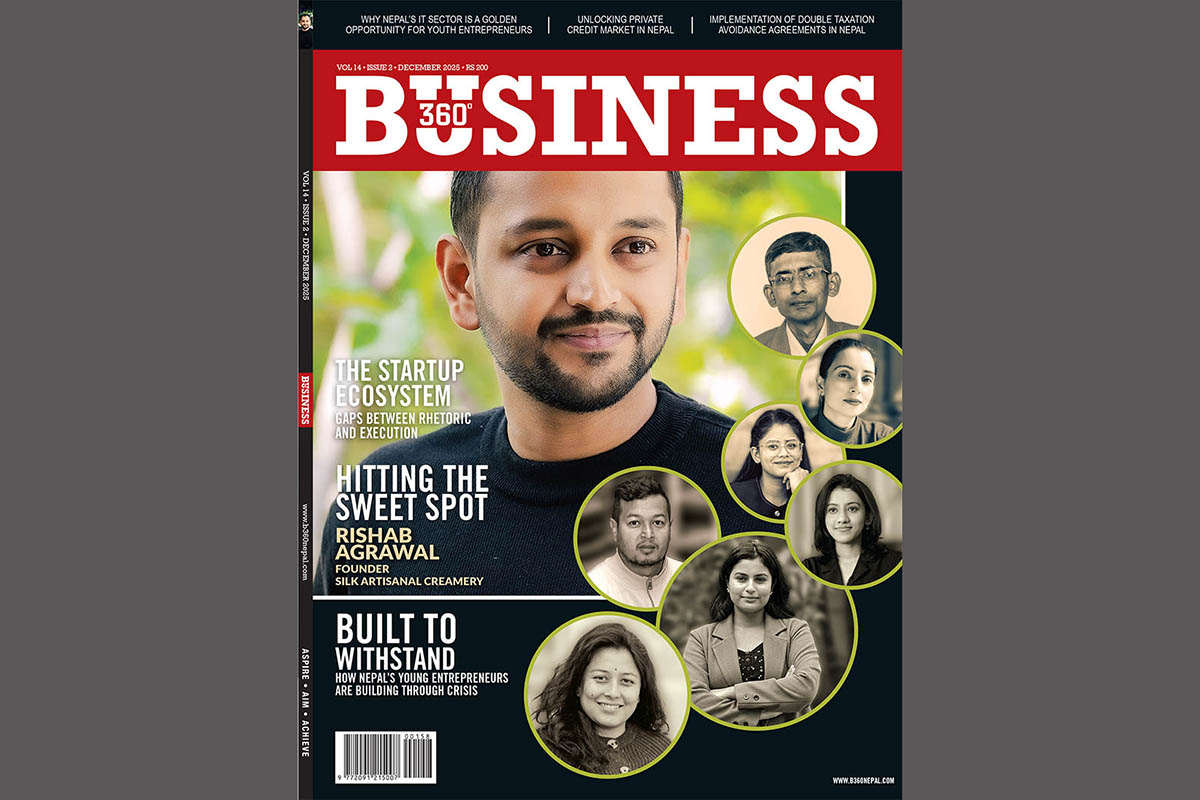
-1767340083.jpg)
